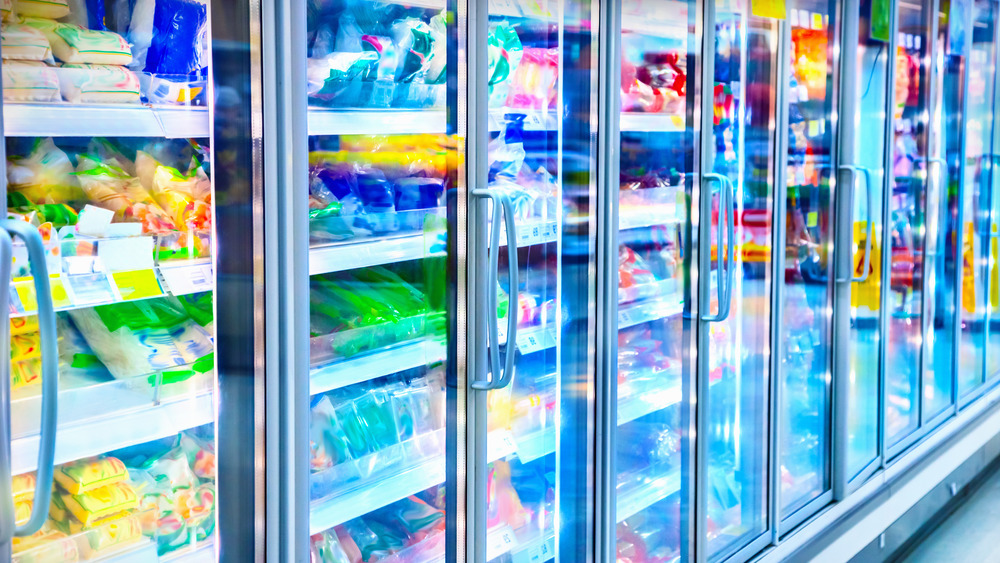Don't Buy Another Frozen Dinner Until You Read This
The classic TV dinner has stuck around for decades for a very good reason — when you have worked all day, nothing beats the ease of popping a meal in the oven or microwave and grabbing a bite with minimal effort. Americans still can't get enough of these reliable all-in-one dishes. According to Statista, almost 200 million of us ate one of these entrees in 2020, and with numbers like that, it's no wonder our favorite frozen meal brands keep trying to tempt us with new products every year.
While we can't get enough frozen meals in our lives, some poor nutrition can lurk just beneath the surface of these time-tested staples. Dr. Elizabeth Klingbeil, Ph.D., registered dietitian nutritionist and assistant professor of Nutrition at Johnson and Wales University in Rhode Island, recognizes this fact and aims to separate nutritional fact from fiction when it comes to picking healthy frozen meals.
"Nowadays, although there are certain things that you need to look out for when choosing a frozen meal, there are plenty of very healthy frozen meal options that you can find at your local grocery," Dr. Klingbeil told Mashed. Sodium levels, fat content, and overall nutrition level separate the good from the bad when it comes to selecting the perfect frozen entree.
Frozen dinners can be loaded with tons of salt and fat
When you grab a frozen entree out of the freezer section, look at the sodium count before placing the item in your cart. "The more 'processing' a food undergoes, the more sodium you will typically find in it," Dr. Klingbeil said.
"Now, with new food science technologies this may not always be the case, but consumers should always be reading the food labels to check the amount of sodium that is in their frozen meals," Dr. Klingbeil explained. "There are plenty of freezer meals that don't have high amounts of sodium used to preserve and add flavor, but you have to look for them. A good goal is to aim for meals that have no more than 600 mg of sodium per serving."
While the daily recommended amount of sodium tops out at 2,300 mg, the true standard should lean closer to 1,500, according to the American Heart Association.
After you check the sodium count, look at how much fat appears in each frozen dinner. "Your typical fried, cheesy and meat-centered freezer meals are going to be high in fat, specifically saturated fat," Dr. Klingbeil continued. "Saturated fat intake should not exceed 10 percent of an individual's daily calorie intake. People need to be aware of high [amounts of] saturated fat and should try to find meals that [have lower] amounts."
After checking out sodium levels and fat content, don't assume you're out of the woods just yet! You need to check out the overall nutrition of the meal.
Look for the highest amount of whole foods in your frozen meals
While frozen meals can give us a break from our daily grind, they probably can't do a ton when it comes to providing the proper amounts of vitamins and minerals. "[Freezer] meals can actually be great options for individuals — if you choose the right ones," Dr. Klingbeil said.
"When choosing a meal, look for meals that [contain] a variety of foods: whole grains, fruits, vegetables, proteins. [Oftentimes], freezer foods can be a cheaper way to get fruits and vegetables than the fresh produce option!" Dr. Klingbeil explained. "This can be a great way for individuals to get nutrients that Americans are often deficient in, such as Vitamin A, D, fiber, and potassium."
If all of this has turned you away from the idea of picking up your favorite frozen meals, don't get too turned off.
"Freezer meals don't deserve the bad reputation that they often receive," Dr. Klingbeil continued. "In fact, they can be a great way for people to get a well-balanced, healthy meal with nutritious foods that they may not have prepared on their own. When shopping for freezer foods, read the nutrition facts label to avoid high amounts of sodium and saturated fats, [emphasize] meals that have fiber in them and choose meals that contain a variety of grains, proteins, fruits, and vegetables."
Next time a craving hits, just remember to shop smart and avoid products loaded with fat and salt to find a meal that's both convenient and nutritious.


